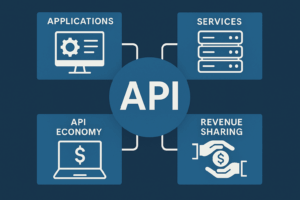The Hidden Backbone of Digital Services APIs, or Application Programming Interfaces, are the silent engines that power much of today’s digital experience. From ordering food and navigating maps to streaming content or signing in with a single click, APIs form the bridge that connects software applications, enabling a seamless user experience. Their role has expanded far beyond tech departments—they are now strategic business assets fueling entire ecosystems.
This post provides a deeper look into what APIs are, how they function in everyday services, and how they are shaping a trillion-dollar API economy. By examining definitions, real-world use cases, revenue models, and a case study, we’ll uncover why APIs are indispensable in the digital economy.
1. What Is an API?
Definition and Analogy An API is a structured interface that allows software components to interact. It can be thought of like a restaurant menu: you don’t need to understand how to cook the meal—you just need to place an order. Similarly, apps don’t need to know the internal workings of a server; they only need to send valid API requests and receive structured responses.
Standardization and Formats APIs often follow standard communication protocols such as REST, SOAP, or GraphQL. RESTful APIs are among the most popular, enabling stateless, URL-based interaction with servers. GraphQL, on the other hand, allows for more flexible data queries, optimizing responses and reducing over-fetching.
Why It Matters APIs abstract complexity and provide developers with powerful tools to reuse functionality, build faster, and collaborate across teams and platforms. This abstraction is fundamental to the modular architecture of modern apps and services.
2. How APIs Work in Practice
Example: Travel Booking A travel aggregator like Expedia doesn’t maintain its own flight schedules. Instead, it pulls data from multiple airline APIs. These APIs provide real-time flight availability, pricing, and seat options. Without them, the app would be outdated and inefficient.
Security and Speed Optimization To ensure safe and efficient communication, APIs often use OAuth 2.0 for authorization, API keys for usage tracking, and caching mechanisms to reduce redundant data requests. These layers of control keep data secure and services reliable.
Scalability and Monitoring Cloud platforms and API gateways (e.g., AWS API Gateway, Kong, or Apigee) allow developers to monitor usage, throttle excessive requests, and scale responses across millions of devices—making APIs production-ready for global audiences.
3. Popular API Use Cases Across Industries
3.1 Payment Integration Stripe, PayPal, and Square offer APIs that enable checkout, subscriptions, invoicing, and fraud prevention. These APIs are used by millions of businesses worldwide, from startups to enterprise platforms.
3.2 Social Media Features APIs from Facebook, Instagram, LinkedIn, and TikTok provide login services, post scheduling, user insights, and advertising automation.
3.3 AI and Automation OpenAI, Google Cloud AI, and Amazon Rekognition expose APIs for natural language processing, image labeling, and text summarization. Developers can build smart assistants, recommendation engines, and content generators.
3.4 Maps and Geolocation Google Maps, Mapbox, and Here APIs power location-based services, distance calculations, delivery tracking, and more.
3.5 Financial Services APIs from Plaid, Yodlee, and MX securely connect fintech platforms to user bank accounts, transaction histories, and credit profiles. Open Banking initiatives have made such integrations a standard.
4. The API Economy: How APIs Generate Revenue
4.1 Freemium Models Freemium APIs offer basic functionality at no cost with limits on volume or features. Developers pay when they scale or need advanced capabilities. This model supports easy adoption and future monetization.
4.2 Tiered Pricing Plans APIs often have usage tiers based on monthly requests, support level, or feature depth. Businesses choose plans that match their scale, with pricing models ranging from per-request charges to flat subscriptions.
4.3 Revenue Sharing Models Third-party tools that embed APIs (e.g., SMS, video, or payment APIs) often enter into revenue-sharing partnerships with providers. This aligns incentives and encourages integration.
4.4 API Marketplaces Platforms like RapidAPI, AWS Marketplace, and Azure Marketplace help developers discover and consume APIs. Providers list their APIs, monetize them through subscriptions or usage fees, and get global exposure.
4.5 Enterprise Licensing Some API vendors sign multi-year licensing deals with corporations that need guaranteed uptime, support SLAs, and custom integrations. These contracts often generate millions in annual recurring revenue.
5. Case Study: Monetizing OpenAI’s GPT API
Flexible Pricing for Scalable AI OpenAI’s GPT API offers flexible token-based pricing, where each API call consumes a number of tokens depending on the text’s length and complexity. Pricing tiers vary by model—GPT-3.5 for affordable utility, GPT-4 for premium applications.
Ecosystem and Revenue Channels OpenAI allows partners and developers to resell or integrate GPT models into their applications. SaaS products built on OpenAI’s backend (e.g., copywriters, coding assistants) generate revenue, a portion of which flows back to OpenAI via API usage.
Broader Platform Strategy The success of the GPT API illustrates how a well-designed API can become the backbone of hundreds of new tools and platforms, each generating value while expanding the original API provider’s ecosystem.
Conclusion
Why APIs Matter More Than Ever APIs enable modular innovation at scale. By abstracting complexity and promoting reuse, they empower developers to focus on delivering value, not reinventing the wheel. In sectors like finance, healthcare, logistics, and entertainment, APIs underpin critical infrastructure.
As we move toward even more integrated, real-time digital experiences—think IoT, autonomous vehicles, and generative AI—the demand for scalable, reliable APIs will only grow. For developers, business strategists, and investors, APIs are no longer optional—they’re foundational.










